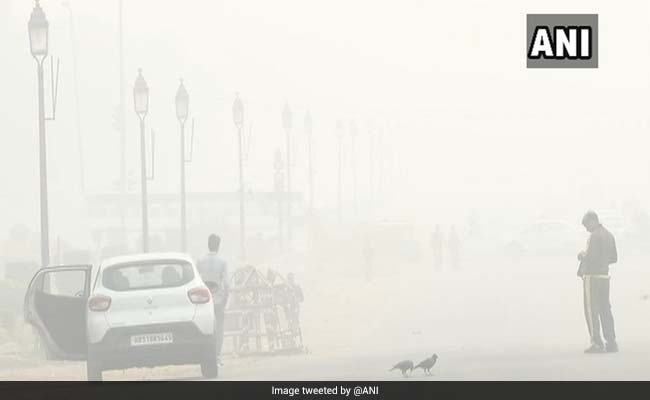Pollution in Delhi: People burst crackers outside the two hour time period stipulated by the top court
As Delhi continues to grapple with rising air pollution, the air quality dropped and Delhi pollution level slipped to "very poor" category and on Diwali night on Wednesday.
A thick haze engulfed the city as people in the city continued to burst firecrackers long after the deadline set by the Supreme Court. The overall Air Quality Index (AQI) was recorded at 302 at 11 pm, which fell in the very poor category, according to the Central Pollution Control Board.
The Supreme Court had allowed bursting of firecrackers from 8 pm to 10 pm only on Diwali and other festivals. It had also allowed manufacture and sale of only "green crackers", which have low light and sound emission and less harmful chemicals.
The situation was similar, if not worse, in the neighbouring areas of Delhi such as Gurugram, Noida and Ghaziabad, where crackers were burst as usual, raising question marks on the efficacy of the administration in enforcing the top court's ban.
Here are the highlights of the air pollution in Delhi after Diwali:
SAFAR said that surface winds have continued to play a major role, it said, as it was calm (2.1 kmph) on Thursday afternoon, so pollution levels were expected to build-up rapidly due to the stagnation.
"The contribution of stubble fire appears to be marginal so far," it added.
The overall air quality index jumped to 574 which falls in the "severe-plus emergency" category, according to data by the Centre-run SAFAR (System of Air Quality and Weather Forecasting And Research).
Delhi's air quality typically worsens in winter, due to pollution from the burning of rice stubble, diesel engines, coal-fired power plants and industrial emissions.
Delhi Records Worst Air Quality Of Year After DiwaliAn AQI between 0 and 50 is considered "good", 51 and 100 satisfactory", 101 and 200 "moderate", 201 and 300 "poor", 301 and 400 "very poor", and 401 and 500 "severe". Above 500 is "severe-plus emergency" category.
The Delhi Air Quality Index is around 574 at present. Air Quality Index entered in severe category at 2 AM after midnight on Thursday and will continue to remain in severe category until evening, a senior official said.
Workers of Public Works Department (PWD) sprinkle water in Anand Vihar area to settle the dust as a pollution control measure.
In October, Supreme Court allowed the use of "green" firecrackers for Diwali but only if they were let off between 8-10 pm. However, there were no "green" fireworks available for sale and many fireworks were let off before and after the designated two-hour period.
Authorities have been reluctant to enforce an outright ban on the use of fireworks to avoid offending millions of Hindus across the country, for whom Diwali is one of the biggest festivals.
The burning of cracker have lead to the thick smog in the national capital.
Smog at Rajpath
As many as 209 calls were received by the Delhi Fire Services on Diwali, including one related to a huge fire in a factory at Bawana, officials said.
Of these, 89 calls were related to fire incidents at garbage and dumpyards, while the rest were related to fire incidents involving electric wires, at factories and residential areas, a senior Delhi Fire Services officer said.
The officials said the number of calls related to firecrackers was comparatively low, but there was no decline in the number of calls related to fire incidents.
Health Hazards A "very poor" AQI essentially means that people may suffer from respiratory illnesses on a prolonged exposure to such air. If the air quality dips further, the AQI will turn "severe", which may trouble even those with sound health conditions and seriously affect those with ailments.
The apparent lack of concern about the toxic air - whether through ignorance or apathy - gives politicians the cover they need for failing to address the problem, say environmental activists and others. Tiny particulate matter can cause major health problems.
In recent weeks, Delhi doctors have reported an increase in patients with respiratory problems.
The SAFAR forecast "bad" air quality Thursday even though partially toxic crackers were burst as compared to 2017. It also said the pollution levels would peak between 11 am and 3 am Wednesday and Thursday.
Each year, smoke from festival firecrackers significantly adds to pollution levels in Delhi and its satellite cities, resulting a haze that can linger for days as wind speeds drop in the cooler weather.
The Supreme Court order to burst crackers from 8 pm to 10 pm only on Diwali and other festivals were not followed properly. Several areas showed a spike in the air pollution.
Areas like Anand Vihar, ITO and Jahangirpuri recorded very high pollution levels.
Violations of the Supreme Court order were reported from Mayur Vihar Extension, Lajpat Nagar, Lutyens Delhi, IP extension, Dwarka, Noida Sector 78 among other places.
The air quality started deteriorating rapidly from 7 pm. The AQI was 281 at 7 pm. It rose to 291 at 8 pm and further deteriorated to 294 at 9 pm and 296 at 10 pm, according to the CPCB.